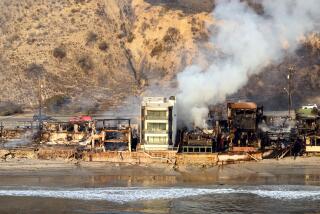Opinion: Our coastal waters are in trouble. Here’s how we can help save them and fight the drought
- Share via
As a scientist and the executive director of the Bay Foundation, I’ve spent years filling in Angelenos on the important but admittedly unpleasant details of how Los Angeles treats and discharges its sewage and stormwater into the ocean. For decades, this L.A. story had a serious yuck factor. It was only a few years ago that we were looking at a wide dead zone on the bottom of Santa Monica Bay. The water had little or no oxygen in it, a result of bacterial decomposition of the less-than-complete treatment of our human waste. Fish were few, and the ones that survived had lesions and other infirmities.
Thankfully, improved sewage treatment processes and efforts to divert dry-weather runoff to our treatment plants, rather than allowing it to dribble onto or under our beaches, have allowed the water in Santa Monica Bay to improve. The wildlife is healthier, and we can surf or swim safely most of the time (when it’s not raining, at least). The center of the bay is alive once again.
That said, scientists such as myself are, generally speaking, a restless bunch; as soon as we figure something out, we’re on to the next hypothesis, the next experiment and more data collection. So with the bacterial and solids loading in our bay largely under control, it’s time to tell a new and equally important story: the potentially overwhelming nutrient load in our coastal waters.
We may be treating our sewage and our runoff better than we used to, but we’re still dumping massive amounts of nutrients --nitrogen, phosphate, and iron -- from our waste into the water. For Santa Monica Bay, the value of this nutrient input from treated sewage and stormwater runoff is equal to or greater than what the ocean brings into the bay in a given year! So welcome a new era. By dumping hundreds of millions of gallons of sewage discharge into the bay every day, we are, from a nutrient perspective, as powerful as the ocean. (For more detail, see Article 4.5 “Nutrients and Hypoxia” of the State of the Bay Report, published in January 2016 by the Santa Monica Bay National Estuary Program.)
So what does all this mean?
It means that though we’re no longer poisoning the bay with bacteria, we’re still significantly altering the basis of the marine food web, which affects all the life in our waters “from the bottom up,” as ecologists say. Data collected from Santa Barbara down to the U.S.-Mexico border show that nutrients from human sources are driving the formation of harmful algal blooms, which contribute to the acidification of coastal waters, form dead zones in the ocean (with little or no oxygen) and can be directly toxic to people and wildlife.
The latest wrinkle in this saga of biological, physical and chemical oceanography is the growing understanding that the sea is becoming more acidic due to excess atmospheric carbon being dissolved in the ocean -- a direct result of burning fossil fuels. The nutrient pollution I’ve described appears to be compounding this already growing problem along our coastal waters. This is worrisome, because the shells of plankton and larvae are increasingly facing the risk of being dissolved by the acidic, or low pH, water. We are, in essence, requiring these organisms, which produce half of the world’s oxygen, to spend excess energy repairing their own skeletons, instead of reproducing and making more oxygen.
Our bay is like a UFC cage match out there, with the denizens of the deep taking a beating! And it’s our own personal biology making the impact, quietly killing the bay.
The saving grace of this potentially tragic situation we find ourselves in is that the solution is easy. We simply need to turn the pipe around and put the water and an ocean’s worth of nutrients to good use back on land, where we need it. Recycling our wastewater -- like they do successfully in Orange County -- would eliminate the great majority of nutrient pollution in the bay. It will enable us to live more sustainability and insulate us from climate change, drought and water scarcity.
The technology is there. We can enhance our treatment procedures and then irrigate and/or inject this water into the ground -- rather than flushing it out the end of a pipe five miles off of our coast. The land will act as a filter, and L.A. County residents will have a renewable supply of drinking water waiting for them underground, regardless of the weather conditions above.
California’s drought looks as though it will be the new normal. The bay is in desperate need of a fix. We have the rare opportunity to help ourselves and the environment through one smart investment.
L.A. has fought hard to protect its coast. We know everyone loves our beaches; lifeguards counted about 40 million of us along the beaches last year. It’s time to bring that same passion to fighting the drought. By recycling our water, we can not only quench our thirst, we can stop the quiet killing of the bay.
Tom Ford is executive director of the Bay Foundation. Learn more about his work at www.santamonicabay.org, or on Twitter @SMBRF.
Follow the Opinion section on Twitter @latimesopinion and Facebook
More to Read
A cure for the common opinion
Get thought-provoking perspectives with our weekly newsletter.
You may occasionally receive promotional content from the Los Angeles Times.










